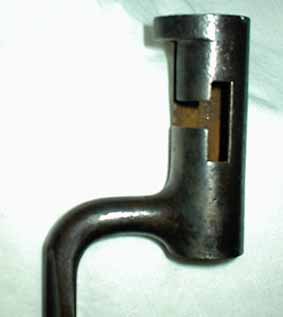(aka "Conversion" Bayonet)

This is a socket bayonet manufactured - or modified - from the period of 1855 to about 1861; it was intended to replace
the bayonets lost or required to meet requirements for the US Model 1816 Flintlock Muskets converted to percussion in the early 1850s. It was the last of the US Model 1816 Bayonets and
the true predecessor to the US Model 1855 series bayonets.
They are typically American in design in that they do not have a blade "shoulder." They have deep side fullers (forming a "T" in cross-section) with a top face-flute (or fuller)
that runs almost the full length of the blade (about 16-3/4"); the standard US Model 1816 has a top face flute of about 9" nominally. The blade length is ~17-3/4" with an ~1" ricasso. Blade
width at the ricasso is ~3/4".
The socket length is 3"; internal diameter is ~.81; muzzle-length is 1-1/4"; These are attached by fitting them over the barrel muzzle, and fastened into position by means of a
T-shaped mortise slot; this bayonet does not employ a locking ring.
All metal construction.
These were designed to fit the various US manufactured .69 caliber flintlock muskets, converted to percussion in the 1850s, just prior to the Civil War.
Blade length is about 18" and muzzle ring diameter is ~0.781" (internal); socket length is ~3".
Scabbards were leather with sheet-metal drag, tear-drop finial; leather belt loop, riveted or possibly stitched.
This variant of the US Model 1816 most certainly saw action in the Civil War.
